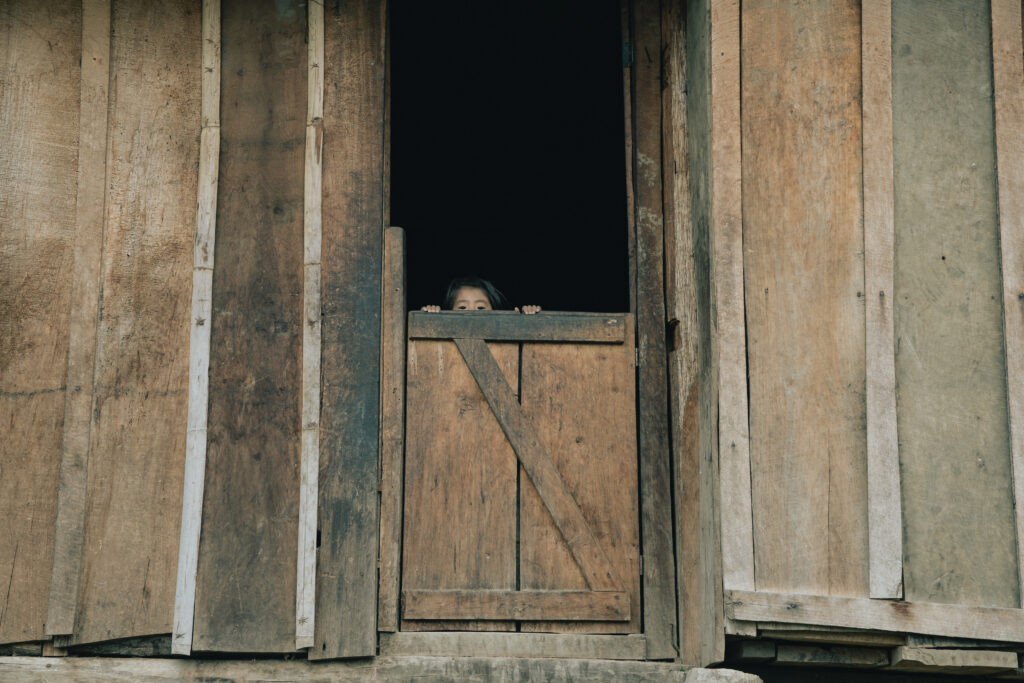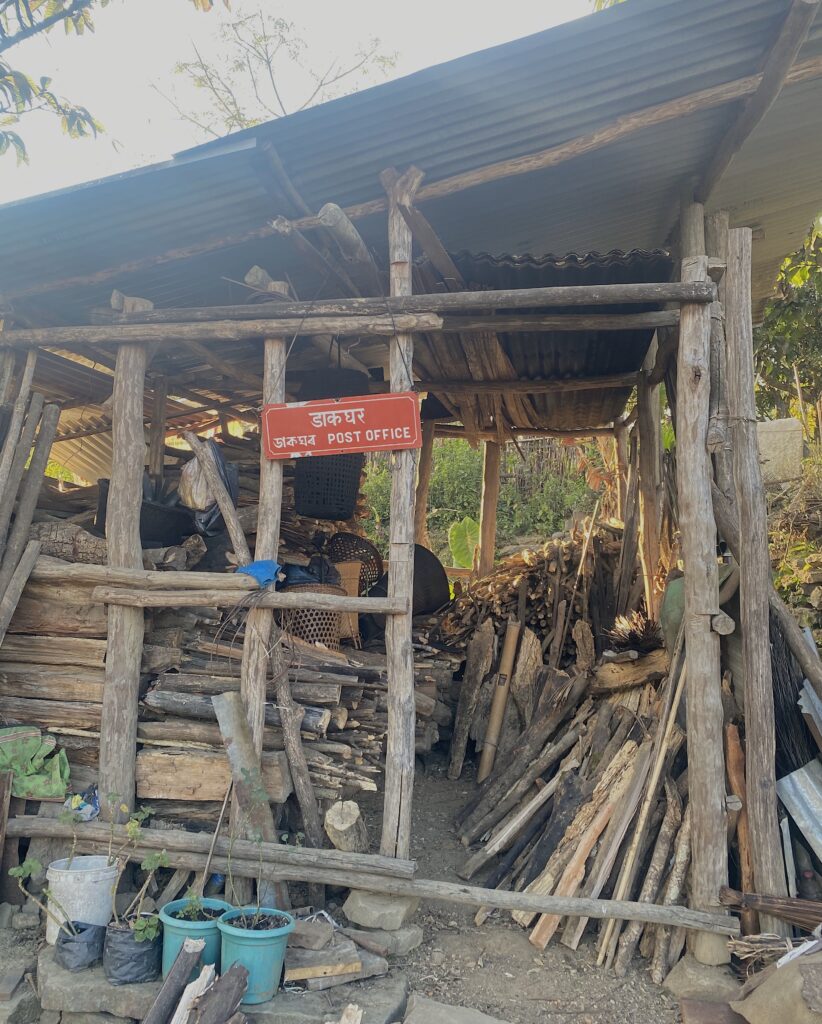A Mausoleum of Our Everydays/Nai nsang negu herouki

“A Mausoleum of Our Everydays” is part of the collection Poems of Witness and Possibility: Inside Zones of Conflict. Read the introduction to the collection here.
A Mauseoleum of Our Everydays
Asphyxiating thoughts
Suffocating words
The tie around the collar tightens
Like the hands of a d
r
o
w
n ing person.
Pale as raw flesh, clammy as a snail’s back
Stranded as in an elevator
Hurtling toward deafening darkness
The endless lull of a rickety train
Vertigo ever-present
Haunting memories of adolescence
Tears wrapped in math worksheets
Relentless, monotonous, typing
Little black eyeballs darting like the needle of a loom
Marching hands of a clock, digital nightmares
Boxes upon taxes, reminders and mails
Poking at sanity, door shutters, alarm ceaselessly calling—
Now a river, now a bird, now a mountain, now a garden.
Consumed in 720p, two-dimensional escapades
Universe caressing our finger tips, copulating
Brain cells, bile of our stomachs.
“I hope I meet your schedule”
Time is measured in linear terms
B u t
Plays out like children playing hopscotch
Like falling leaves creating unending ripples
Like an avalanche careening downward
Like the quiet stillness of a morgue
A mausoleum of our everydays
How do we measure value?
How do we unironically say “It is what it is?”
Like Lorca’s two snails, the mind stays in a Microsoft .07 picture-perfect meadow
Away.
From:
The peopling at Ima market,
tourists at Trafalgar Square
A bamboo raft afloat at Aga ki,
[1]
[1]
Aga ki literally translates as “Aga River” in Liangmai, the language of the Liangmai community among the Nagas. The river is situated high up in the hills around Kabonram and Puilong villages in Tamenlong district, Manipur. It flows downward to join the Barak River in the valley.
a pier on the shores of Moselle
Shadows of a once-great hangseuki in Magulong,
[2]
[2]
Hangseuki translates as “house for boys” or “male dormitory.” Often referred to as “Morungs” in major literature concerning the Nagas, this word has been taken from the Zeme community. I specifically refer to Magulong village in Manipur. Due to the onset of Christianity, older institutions of community-led learning came to be replaced by churches. The juxtaposition of two places seemingly far removed from one another is my (minor) attempt at highlighting the stipulated use of language and imagery. What would deviations mean? What would ambiguities bring to light? What are the borders distinguishing the “local” and the “global”?
Stone ruins of Chateau de Taillebourg
The mouth stretches
“How do I meaning-make these ambiguities?”
Pores of our tongues stretch into vines
Language languaging like rolling dice
Ancient villages here, Petrarchan ruins there
Cherubs nestling along grapes in soft-orange summertime
Someone observes life, hastily, and makes notes.
We laugh loudly at “crude” hilltown humor
Even as mucus-streaked children balance sticks atop cow-dung patches singing “Happy Birthday!”
Mothers wrapped in secondhand Sunday best
My crooked toes sticking out of ill-fitting shoes
(Forgive me, we will not become French-speaking tribals)
Resentful, perhaps. Angry, always.
I
I magine
I nnumerable
I’s.
They plod along light-brown windowsills
They trip among numerous bodies in woven shrouds
Huddled around a raging fire
Sky brightly lit by kerosene
“Hope my email finds you well and in good health, and in great happiness, and in unimaginable despair”
I close my eyes and think of that orange tree
Singularity. 2017 December.
The branches stretched a mile high as my grandfather climbed a rickety ladder
Sunbeams streamed through moss-colored leaves
I remember remembering an azure sky
I foolishly thought of many poems—
Without names
And lines without borders
And letters waiting for a home
Somewhere far not here, not in my four walls, not in my gated university
Gunshots ring out gayly
Thudthudding as a spirit-filled church
Bidding adieu to inspiration
My feet stretch out like flayed sardines
In Amma’s basket
My hands peeling off my body like a poster rife with slogans
“HOMELAND!” “UNITY!” “SOLIDARITY!” “RECLAMATION!”
I do not feel nostalgia
A yearning rather
A homeless sound
A pageless letter
No listeners or tellers
Tired we are
Returning
Anywhere and Everywhere
Children of our unscripted ancestors.
Nai nsang negu herouki
—Translated into Zeme by Peace Newme
Tenang kekbe maning
[3]
[3]
Regarding the translation, there were many instances where it was difficult to find equivalences between Zeme and English. The primary translator, Peace Newme, translated both literally and meaning-wise. In his task of translating, he consulted different local speakers, of note Tinggeu Zeme. The methodology of translation can be seen as one forged in collaboration. The challenges of rendering English-ness into a pure tonal language system full of songliness was not lost on the translators.
Misui lupet lakbe sam ramme
Miguang ge tie ze pi ntip si gai
Hedui ge k
e
h
a
k bam peu ba gum ze
Hemei ngei gum phada, teluai ne chingkuak gum heneitiang zai hegeigak
Elevator ge bam gum, bangdiak gai
Keleulia be kemuibe mbia pak ketie wang
Heluihiak-periehie be train ne sou tan bam be
Mining nzit che koura gum bam tan
Henabeting ge tew gai dibe nrimsimbe
Math gu leisi kum ge mikdui njui gai be
Peluilung tan bambe, njua tan be, typing tew be
Phaidakpe hengim gum, mimik cheu tikpe nsou ze bam
Ngai ze bambe nchet batang, digital gu kanrimbe
Taxes reige boxes, michu ma pei ningdaube ramme zai mails
Ningching ze rung bambe, nkam kai be, alarm nra souchi tadi be
Neka ahne ngeuki, neka ahne namruine, neka ahne himlua, neka ahne kerie
720p ge helung leine kai, two-dimension me pak mbia ra tew
Kehung be phui ze kedeirei ne miba tun ze dei ze bam, peiherua gai ze bam
Minkuak gu cells, mibung gene madui khari pet pe
“I hope I meet your schedule”
Pehi ze ntatui ze nchet che bam
K a n e
Hena me haga ntha gum pet pet gut gut
Reheuneu ne ngaikeu ze hedui pei ngairip kai gum
Kebun kang nkuarua keu gum
Morgue ge ntimrim bam gum
N-a-i-n-s-a-n-g-n-e gu herouki
Dai gum pemi ndeu ra?
Ndai gum peling sing ne “ai ze ai delei” sara lou?
Lorca gu teluai ne kena gum, mi maning ze Microsoft .07 gu pebam ndiakri zai nturui bege sou ntak ze bam
Chi lia me.
From:
Ima chaiki ge mina ramma kebuak chuak be,
Trafalgar Square ge hesang-tebei tewme bambe
Aga ki ge heliam ntin rua bambe,
Moselle kung ge pier bam be
Nda ge heretset be Magulong ge bam be hangseuki mie,
Chateau de Taillebourg gu ntu rie ramme
Mimui ze nta-zang pet gai
“Aipou kebuak chuak bambe ze ndai gum I ne perimba teleu ra?”
Anui leige peki ramme ze mahim ramme ge nta hang
Dice cheu nkuarua bam gum, helet ramme helet tew ze bam
Nda gene aipou bäm leize bam, Petrarchan ting gu merua rie chi lia bam
Renua huaibe tinglum ting ge nruine ramme ngumchi jeu ge pechip tewlu nkeu bam
Hangsang mene ringting ze chet bam, keluak rakche zai pelam ge rou ze bam
Hegua namdi gu henui ge anui nui keleu lia gai
Penui neu jouphin bam be nepoine ramme kebui ba ge singtang tou gai lu “happy birthday!” leu tew be
Hepuime ramme pakenabe Sunday phaini ne njui bambe
Api tun mbung ring ze apichub chei ren beige nkia pet be
(Achu lungai lou, anui French let sabe tribals chang lak lei)
Helung pumnei be, sam hang ge. Helungpum, pehi nsang ne
I
I ne ning
I ne keseichanglak
I’s.
Gie-hammuibe leubaki kung ge penui tet rua bam
Phaine njui gai lube minapum jeu ge penui mbei rua bam
Hemi touhi bam be ge penui ndui kete
Tinggim ze kenrosene ne tou ba be
“Nang yi bambe zai nang pum yikesang bambe, zai nangsui yibe luage agu mails ne nangchu hedou gai ra hegui lei”
Amik cheu mmui gai lu, chipou kumla bang ze ning lei
Singularity. 2017 Nduikeu.
Apou ne heluihiak be kesua ne njak keu bege, pekhei ramme ze mile aket ria nta hang
Mpet gum ndiakring be reheuneu zeu ge tingche meheu hia pela
I ning lei nzai nchichiak bambe tinggim ze ning bam be
Mie sie ze I ne poem ramme ze ning lei-
Peji gaze
Zai peria gabe lines
Zai kilung ze kua bambe samkie ramme
Mabam aket kedeu me aipou bam mak pe, agu mbie medai ge makpe, kerie-nkam kai bing be University ge mak pe
Hegeitenai ze gimmi kap pet
Herui ne phui be raki gum thudthud tew ze chi bi bi bam
Kakecheube lungsui ze kenui gai
Apui gu nthui ge heka ramme bambe gum
Api kena nta zang pet gai
Slogans ne phui git pe poster gum, aba kena apum gene njut tet che bam
“ARAMKEDEI!” “SUIKET LUNGKET!” “KAHERUABE!” “LUKEDAIBE!”
Aki ze, I made ning heu ze tet dai ra hegui mak
Kane kua bam
Pebam pejei gabe kua
Perua huang be sithi
Nking rame zai sarame ga
Leidibe anui
Heliwangdai ze bam
Pebam nsang ne zai tet nei be bam
Rougai makbe anui poupai ne lung gai be hena meramme.


































